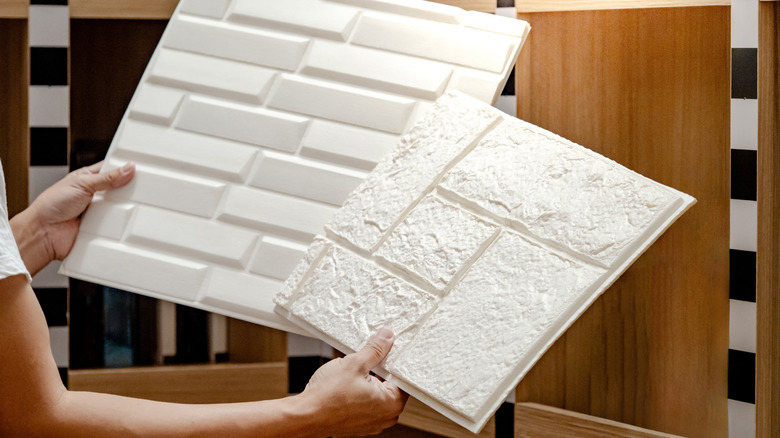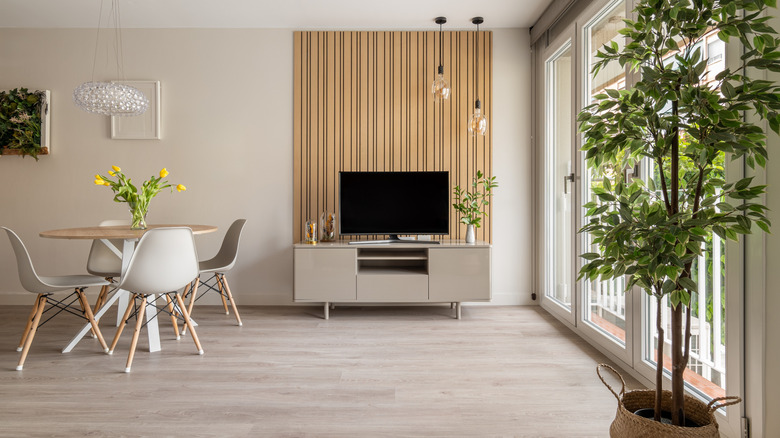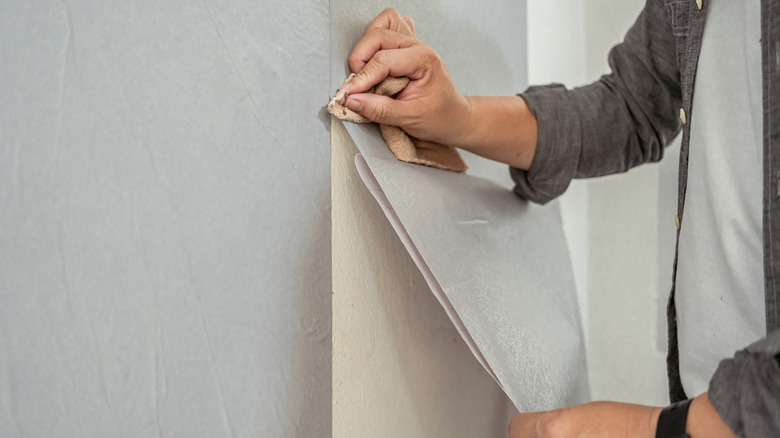Panels Vs Wallpaper: Which Is The Better Accent Wall For Renters
We may receive a commission on purchases made from links.
Renting an apartment or home has its perks — no homeowners insurance, no replacing appliances, and no hefty costs to maintain the structure (in most cases). But there are plenty of limitations, especially when you're interior decorating to revamp your space. Some landlords advise against painting unless you're willing to paint it back the original color or cover repainting costs when you move out. And most won't approve changes like new flooring. Even so, with all the DIY hacks and simple decorating ideas out there, it's easier than ever to make a rental feel more like your own. One easy way to do this is by decorating an accent wall with peel-and-stick panels or wallpaper — the modern, renter-friendly kind, of course.
But before you go grabbing rolls off Amazon or running to the hardware store, it's worth thinking it through. Peel-and-stick wallpaper and adhesive panels can stick really well — like, so well that they might rip off paint or even take chunks of drywall with them when they're removed. So your renter-friendly solution could end up costing you at least part of your security deposit.
That said, they can still add a lot of character to a space. Some of the thicker panels can even help soundproof your home a bit, which is a bonus if you've got paper-thin walls and loud neighbors. Knowing all this ahead of time makes it easier to decide which option is best, if any, and whether it's actually worth it. We're breaking down the pros and cons of both panels and wallpaper so you can decide which is ideal for your rental space before you go sticking anything to your walls.
Wall panels might not work with uneven walls and require some handiwork
Wall panels are generally easy to apply, especially once you get the first horizontal row straight. From there, it's just a matter of stacking them on the wall in an upward fashion, row by row. They add a unique touch to any accent wall, with some even offering a 3D effect. Styles range from PVC wood grain to modern diamond textures, so you can match the look to your vibe. Many are lightweight, too, which makes them easier to attach with renter-friendly methods and less likely to fall off. But there are a few downsides, mostly tied to application.
Not all walls are perfectly straight, so your panels might start slanting during application, which can throw off the entire look. You'll need to measure and mark using a level to keep things lined up. If your wall is uneven, you could also end up with small gaps. Also, be ready to make straight cuts around outlets or switches using a straight-edge knife or even a handsaw.
There's also the matter of how you stick them onto your wall. Some panels come with self-adhesive backings, but reviews, like those for the JOLOV 3D peel-and-stick PE foam wall panels, say they can sometimes leave behind residue or even pieces of the panel. And not all of them work well on rough walls. One workaround is to apply blue painter's tape first, then stick double-sided tape to the panels and press them onto the tape. But blue painter's tape is only designed to stick for about 14 days if you want a clean removal, while with FrogTape, you get up to 21 days. Either way, you could face removal issues or have panels that don't stay in place well.
Wallpaper can leave residue and crease easily
So, is peel-and-stick wallpaper any better for renters? It depends. Between the '60s and '80s, bold and colorful wallpaper was a staple in homes, and honestly, it never really disappeared. The designs just toned down over time and eventually evolved into more modern options, with peel-and-stick wallpaper becoming a go-to for renters. It can be relatively easy to apply if you follow the included guidelines, and it can instantly transform a room when used on an accent wall.
That said, there are a few noteworthy downsides. Not all products are created equal, so you definitely want to read the reviews on any product you're considering. Some brands and styles tend to bend or crease easily, and the thicker options can be harder to work with. Getting peel-and-stick wallpaper on straight is another common struggle, especially without precise measuring. Depending on the brand, the wallpaper might even start to slide down over time. And if you need to reorder another batch, there's always a chance the color won't match exactly, even if it's the same product.
So yes, peel-and-stick wallpaper and panels can do wonders in a rental. But there's also the chance you'll be left with sticky residue or peeled-off paint when it's time to take it down. If that's a risk you're comfortable with — or if you're willing to repaint — consider ordering a small batch first to test it out before going all-in on the whole wall.


